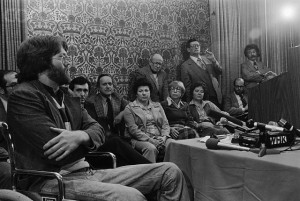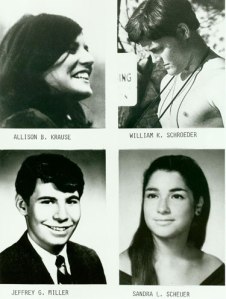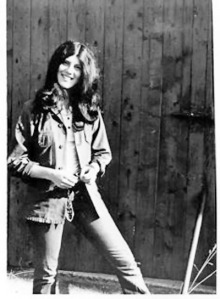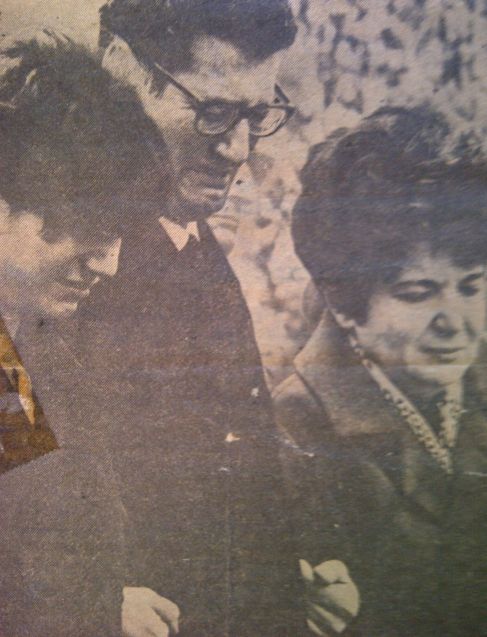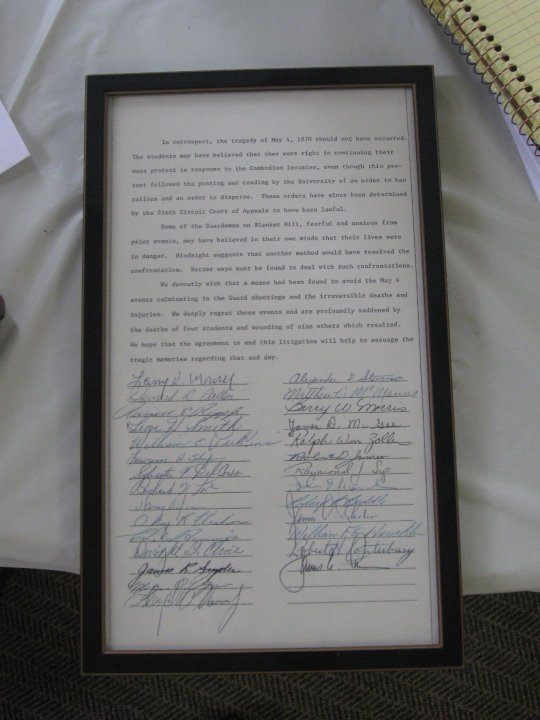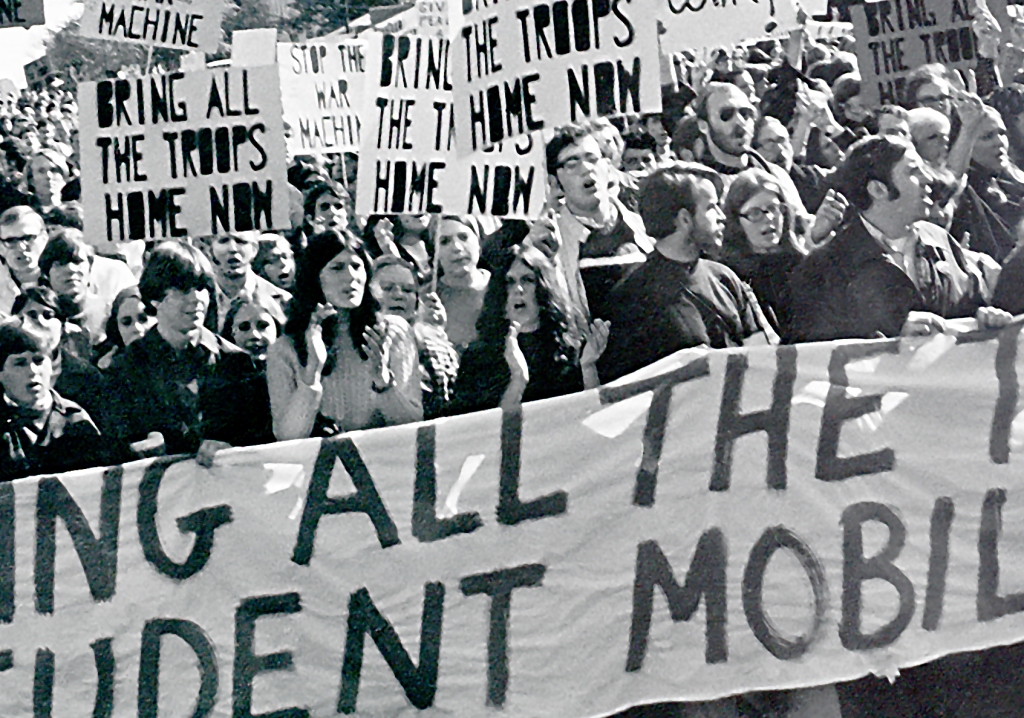
In the summer of 2021, with help from writing coach Karmen Ross, I recorded stories of my life related to the Kent State massacre. These chapters document growing up with Allison and our family’s views related to Allison’s slaughter at 19 years old in the May 4, 1970 Kent State massacre. – Laurel Krause
The next morning on Saturday, May 2nd my parents have a long, serious discussion with Allison over the phone. Dad speaks to her, with Mom offering her input on a phone extension. They are blowing their stacks. Dad wants to know about Allison’s involvement in last night’s mayhem in downtown Kent. Allison tells my parents she wasn’t involved at all, that she’s not a drinker and hadn’t gone to the bars. She promises to stay on campus and out of trouble.
Dad’s concern for Allison as an anti-war protester accelerated when she started college at Kent State. On TV he saw reports of mounting violence against peaceful protest, particularly in D.C.; he knew Allison was demonstrating and didn’t want her hurt. In October and November 1969, resistance to Nixon’s Vietnam war swelled. Dad worried as he watched Nixon taunt college students, including his daughter, knowing it would lead to trouble. He didn’t want her protesting and told her so.
Allison would not be commanded by my father. She felt it was her place to resist the war, along with her friends, as part of the generation being forced to fight in Vietnam, and now Cambodia. Allison’s integrity was everything to her and she lived out her commitment to peace and to the principles of freedom and sovereignty that she believed ought to define our country, and the world. The “hippies” were so maligned during this period but what I know from up close is that Allison truly believed in love – love animated through action, the underlying theme of the 1960’s. She loved life and loved people and she was going to be part of the generation that broke the legacy of war and death we were seeing all around us. And I believe she did this in her own way, and paid a huge price. My sister was valiant and fierce, and above all dedicated to non-violence. Allison stood for peace.
Dad began to see how on TV the demonization of protesters was helping to suppress young people’s freedom of expression, and how this might go on to endanger Allison at Kent State. He saw how the “dirty” and “dangerous” hippie was a trope fervently promoted by Nixon’s administration to make the anti-war protesters appear to be a fringe group of violent lunatics and communists. This coordinated suppression of peaceful Baby Boomers would later become part of public policy and the basis of criminal prosecutions, Kent State included.
In the days leading to these events, President Nixon, Vice President Spiro Agnew and even California governor Ronald Reagan spoke out publicly against young people, demonizing them and their protest movement. Often serving as unaccountable mouthpieces, the media perpetuated these distortions, mainlining their messages to middle America and bolstering the war in Vietnam.
At the time of the Moratorium, President Richard Nixon said, “Now, I understand that there has been, and continues to be, opposition to the war in Vietnam on the campuses and also in the nation. As far as this kind of activity is concerned, we expect it; however, under no circumstances will I be affected whatever by it.” Outrageously, Nixon left no doubt that he would refuse to change course in the face of this groundswell of anti-war protest.
In the fall of 1969 Allison collected money to support anti-war efforts and marched for peace on the Kent State campus. November 1969 brought the historic March on Washington, including the March on Death, as the Moratoriums to End the Vietnam War gained momentum.
Allison traveled by bus from Ohio to D.C. to participate in the Moratorium with her friends. The atmosphere was electric and would go down in the history books as the largest American citizen assembly to date. Hundreds of thousands of protesters arrived in D.C. for the March on Death and half a million assembled for the November 15, 1969 Moratorium Day, taking their demands to the White House. At the National Mall, Allison connected with her high school Maryland friends and heard speeches from Dr. Benjamin Spock, Dick Gregory, David T. Dellinger, Mrs. Coretta Scott King, Dr. Timothy Leary, Leonard Bernstein, Senators George Mc Govern, Charles Goodell and Eugene McCarthy, Abbie Hoffman and Jerry C. Ruben. Music enlivened the crowds as they were uplifted by Peter, Paul and Mary, Arlo Guthrie and Pete Seeger. Seeger led everyone in a 10-minute rendition of John Lennon’s “Give Peace a Chance” and then directly called on President Nixon to end the Vietnam war. It was a heady and hopeful time.
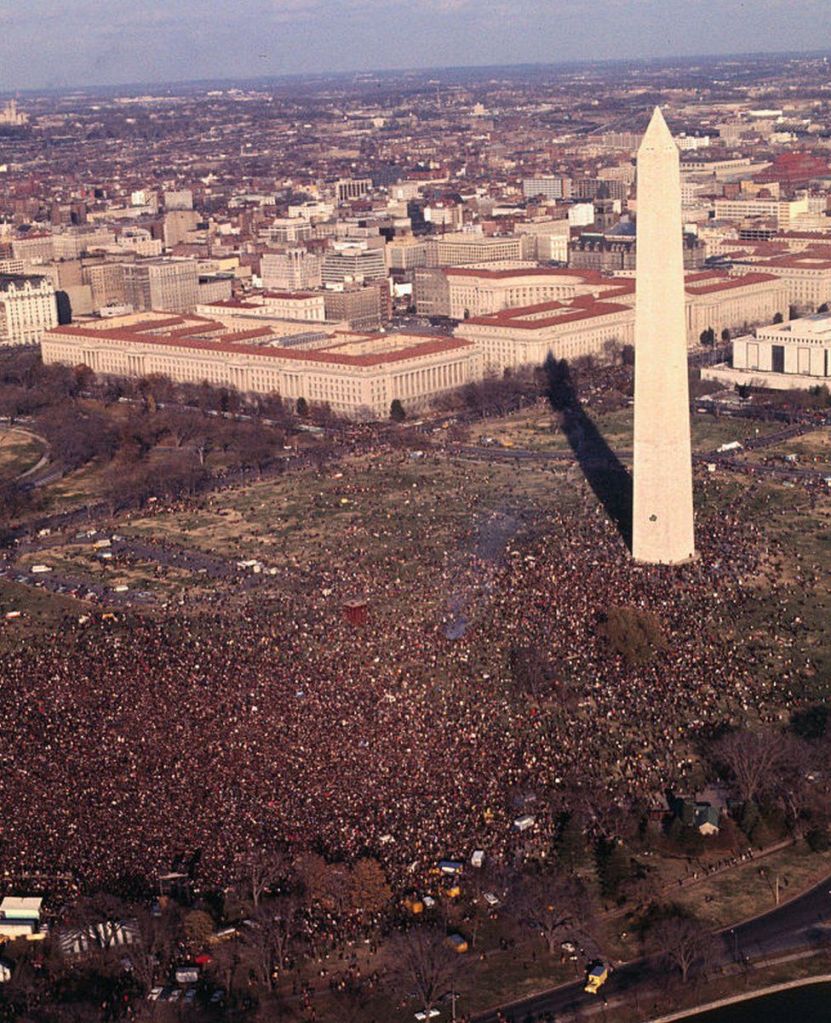
D.C. Moratorium to End the War in Vietnam, November 15, 1969
On this first weekend in May 1970, now half a year after the Moratoriums and with nothing but military escalation to show for the anti-war efforts, there is widespread outrage among the American public. However, on Saturday The New York Times propagates a story about Nixon’s April 30th Cambodia speech being well-received, saying Americans were “positive” in response, in a ratio of six to one. They cover Nixon saying, “President Nixon referred today to some campus radicals who violently oppose his Vietnam policies as ‘bums’ and, in contrast, he said American soldiers were ‘the greatest’.” Nixon went out of his way to smear anti-war protesters, among them my sister.
In our phone call that Saturday, Dad reminds Allison how she defied him in November by going to the March on Washington against his wishes. Allison retorts, “Yes, and I didn’t get arrested or in any trouble either.” She promises she’ll be careful, adding how she’s not a radical and hadn’t even joined Students for a Democratic Society, a campus group that opposed the Vietnam War. As she ends her chat with my parents, Allison repeats that she won’t be going to town and that she’d protect herself.
At the end of the call I speak with Allison, squeezing in a moment to chat, encouraging her to stay safe. I’m worried for her, wishing I could somehow be close to her on campus again. She tells me, “I’m going to be okay.” I never speak to her again.
Ever since the bar closings on Friday night, students detect a mounting Ohio National Guard presence outside the campus gates. This is extremely unsettling as in the past, the National Guard, usually under command of the governor, have only been brought in for extreme situations. Now guardsmen are coming in numbers to bivouack in public school yards in the areas surrounding Kent.
Exercising their constitutional right to assemble, Kent State students gather before dusk on Saturday for a protest at the ROTC building. The ROTC is targeted in order to object to the Reserved Officers Training Corps programs that were a pipeline to the Vietnam war, and also to expose Kent State’s research into military-grade liquid crystals for combat weaponry. The burning of ROTC buildings had become a recurring theme at universities across America as the draft escalated and the response to the war became more desperate. Kent State’s decrepit wooden structure is already slated for demolition, thus of limited value, but it is chosen for its symbolism.
A small group of less than 100 students gather near the ROTC building, an old, stand-alone structure, and attempt to set it alight. The building does not catch fire easily as it had been raining for weeks prior. After several attempts to get it going, the structure finally ignites. From sources present at the fire, I was told that there were again unfamiliar faces in the crowd. The hippies were by no means a majority on campus and they tended to run in the same circles, so they knew each other well. Many students came to believe that informants wearing hippie clothes and longhair wigs were present among them at the ROTC that night and may have been the force behind the final ignition. There is now a well-established record of the extent of government infiltration and surveillance during the Vietnam era, and the involvement of plants during the ROTC incident would not have been unusual. FOIA documents, first-person testimonies, radio interviews and legal proceedings later established the extent of infiltration and surveillance deployed by the Nixon administration. We now know that the CIA CHAOS program was used against anti-war protesters at Kent State, as authorities claimed they needed to rout out campus radicals from other schools, who simply weren’t there. The CIA’s surveillance plots were not new to university leadership mostly because Kent State had been a CIA recruiting school since at least the 1950’s.
Whether related to policing for drugs or anti-war monitoring, there had been mounting tension at Kent State over government agents suspected of walking among them. One student shared later that she heard law enforcement walkie-talkies near the ROTC building blast the message, “The fire isn’t going yet” to the Kent fire brigade. Much later the flames burn a curtain through a broken window and the fire takes off after a series of failed attempts.
The Kent State ROTC building burns down. Whether it is the students or undercovers who set it afire we will probably never know, but we do know the fire fighters, the Ohio National Guard and the state troopers who arrived on campus once the fire got going made sure no one put it out quickly. The authorities were completely hands off in addressing the flames.
The Ohio National Guard watch and wait for the ROTC building to be engulfed. When it comes time to put out the fire, the firemen “discover” their thick fire hoses have been cut by fire axes “made available” at the fire truck and, notably, a machete – an uncommon tool in Ohio. Questions abound: who cut the fire hoses and where did a machete come from?
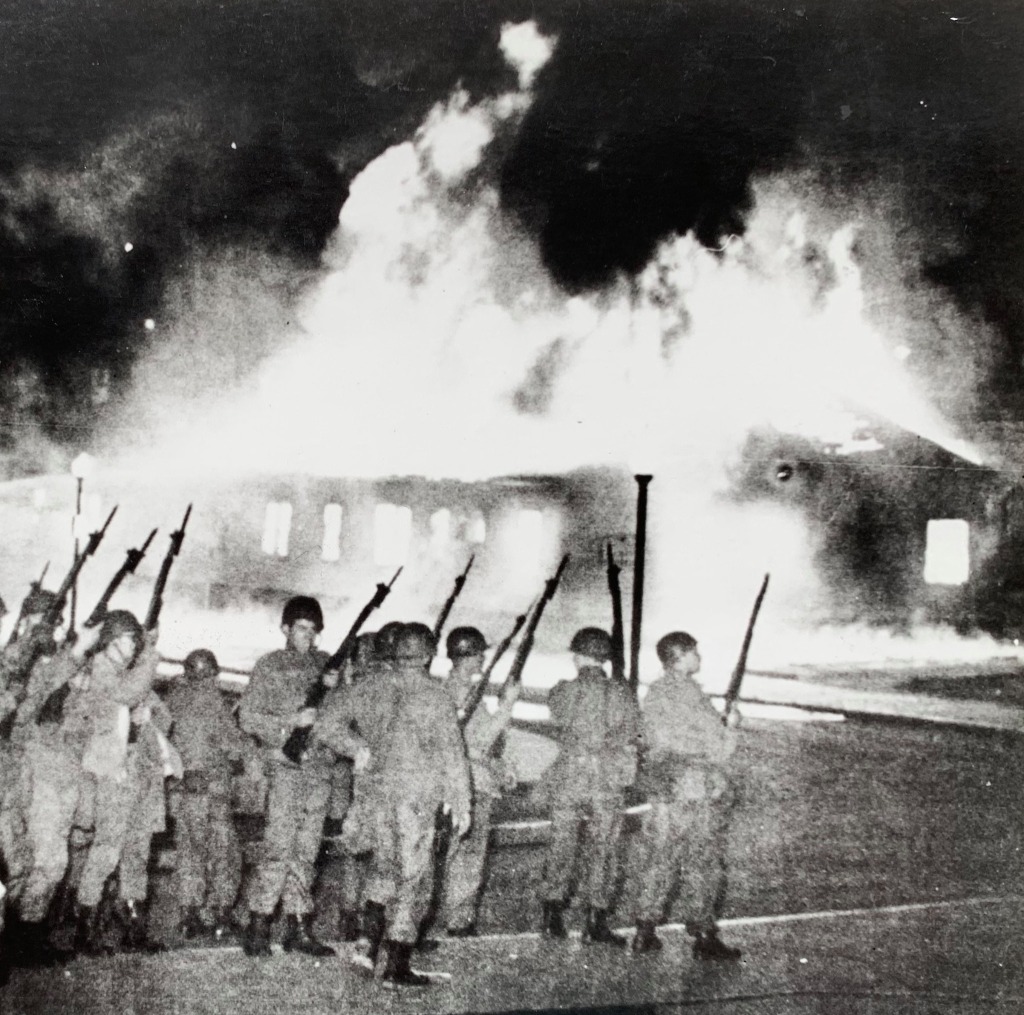
Word of the Kent State ROTC fire spreads quickly around town and then across the nation. In newspaper headlines overnight, Kent State protesters become violent, out-of-control campus radicals and troublemakers with no redeeming qualities. The press play right into the hands of the government and there is very little dispassionate reporting.
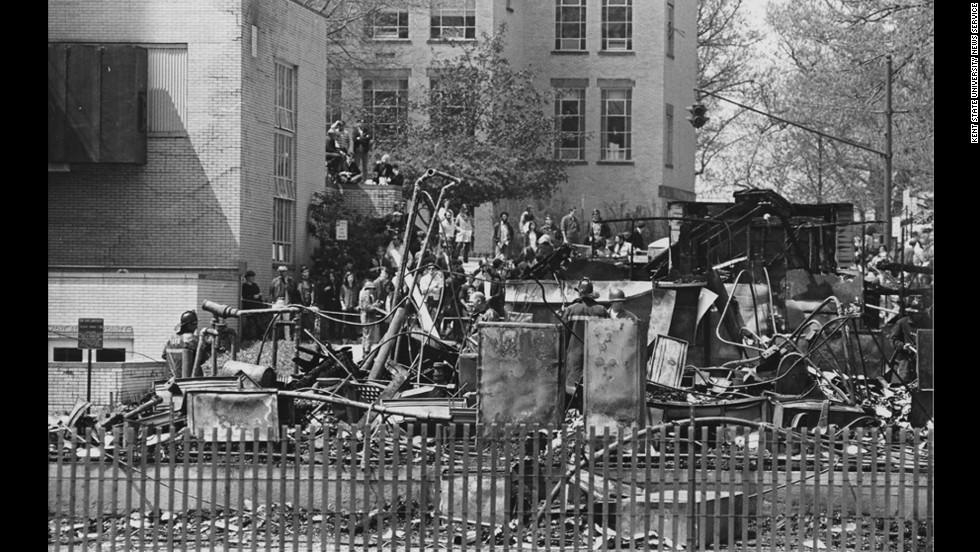
After the ROTC burns down, the atmosphere on campus becomes more militarized. Despite this, the students maintain a determined calm and the next day starts off peacefully.
—
READ MORE EXCERPTS to understand our view of what happened to Allison Krause in the May 4, 1970 Kent State massacre:
May 3, 1970 with Allison Krause at Kent State University https://bit.ly/3Vv3oUN
May 4, 1970 with Allison Krause at Kent State University https://bit.ly/3ARaFoJ
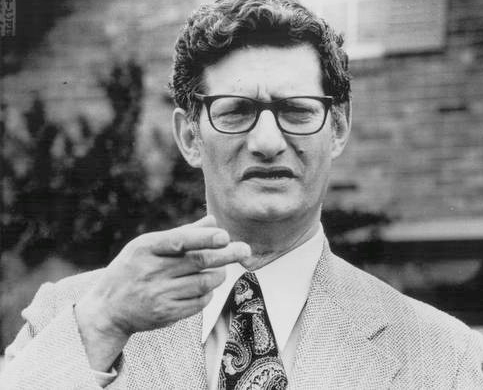
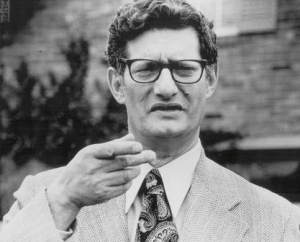 By Shane Harris, published on June 1, 2012 in the
By Shane Harris, published on June 1, 2012 in the  My name is Carlos Jones. I am a musician. I live in Cleveland, Ohio – Shaker Heights to be exact. I’m here today at the request of the family of Allison Beth Krause, to speak for her as we commemorate the 49th year since that particular tragedy.
My name is Carlos Jones. I am a musician. I live in Cleveland, Ohio – Shaker Heights to be exact. I’m here today at the request of the family of Allison Beth Krause, to speak for her as we commemorate the 49th year since that particular tragedy.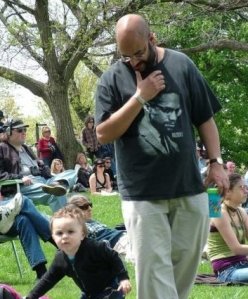 This year marks my 28th commemoration. I have spoken only once for a student, Jeffrey Miller. In my younger years as a student, I thought that Jeff was the one who I had the most in common with—like him, I considered myself a young revolutionary who deeply believed in activism and civil rights. I didn’t realize how much I have in common with Allison until this year.
This year marks my 28th commemoration. I have spoken only once for a student, Jeffrey Miller. In my younger years as a student, I thought that Jeff was the one who I had the most in common with—like him, I considered myself a young revolutionary who deeply believed in activism and civil rights. I didn’t realize how much I have in common with Allison until this year.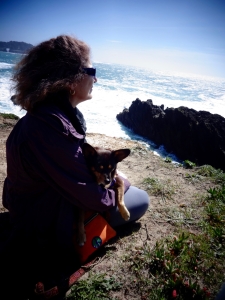 When I first chose to write this paper on Laurel Krause, I was expecting it to be just like any other short research paper on a human being. Read up on their accomplishments, read some interviews, look up different articles, et cetera, et cetera. Little did I know that I would have the wonderful opportunity to sit down and have a phone conversation with Laurel herself. It was a quiet Sunday afternoon on May 1st when I decided to make the call – I had been mulling over the decision as to when to call since hearing back from Laurel. I was extremely nervous to call and make a fool of myself.
When I first chose to write this paper on Laurel Krause, I was expecting it to be just like any other short research paper on a human being. Read up on their accomplishments, read some interviews, look up different articles, et cetera, et cetera. Little did I know that I would have the wonderful opportunity to sit down and have a phone conversation with Laurel herself. It was a quiet Sunday afternoon on May 1st when I decided to make the call – I had been mulling over the decision as to when to call since hearing back from Laurel. I was extremely nervous to call and make a fool of myself.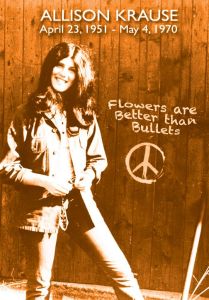 Another May 4th parent has died since last we gathered to commemorate this event. Another mother has left us before the truth is clear and justice is served. My aunt,
Another May 4th parent has died since last we gathered to commemorate this event. Another mother has left us before the truth is clear and justice is served. My aunt,  Last week while I was walking along the California coast near my home, I was called to my mother Doris Krause’s bedside by hospice caregivers informing me that her time was near. Mom had stayed in Pittsburgh, our family home, perhaps for the same reason I went very far away. We shared a tragedy in our family that broke our hearts and wounded our spirits but ultimately deepened the love between us in ways we might not have otherwise known. We have carried this wound for so many years but I arrived back home in Pittsburgh to experience a profound healing with Mom. I am moved to share our experience as we lay her body to rest.
Last week while I was walking along the California coast near my home, I was called to my mother Doris Krause’s bedside by hospice caregivers informing me that her time was near. Mom had stayed in Pittsburgh, our family home, perhaps for the same reason I went very far away. We shared a tragedy in our family that broke our hearts and wounded our spirits but ultimately deepened the love between us in ways we might not have otherwise known. We have carried this wound for so many years but I arrived back home in Pittsburgh to experience a profound healing with Mom. I am moved to share our experience as we lay her body to rest.
